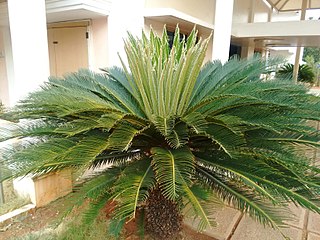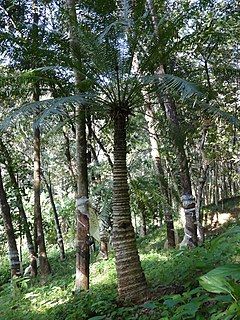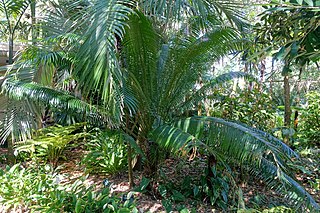
Cycads are seed plants with a very long fossil history that were formerly more abundant and more diverse than they are today. They typically have a stout and woody (ligneous) trunk with a crown of large, hard and stiff, evergreen leaves. They usually have pinnate leaves. The species are dioecious, therefore the individual plants of a species are either male or female. Cycads vary in size from having trunks only a few centimeters to several meters tall. They typically grow very slowly and live very long, with some specimens known to be as much as 1,000 years old. Because of their superficial resemblance, they are sometimes mistaken for palms or ferns, but they are not closely related to either group.

Cycadales is an order of seed plants that includes all the extant cycads. These plants typically have a stout and woody (ligneous) trunk with a crown of large evergreen leaves. They usually have pinnate leaves. The individual plants are either all male or all female (dioecious). Cycads vary in size from having trunks only a few centimeters to several meters tall. They typically grow very slowly and live very long, with some specimens known to be as much as 1,000 years old. Because of the superficial resemblance, they are sometimes confused with and mistaken for palms or ferns, but are only distantly related to either.

Cycas is a genus of plants belonging to a very ancient lineage, the Cycadophyta, which are not closely related to palms, ferns, trees or any other modern group of plants. They are evergreen perennials which achieved their maximum diversity in the Jurassic and Cretaceous periods, when they were distributed almost worldwide. At the end of the Cretaceous, when the non-avian dinosaurs became extinct, so did most of the cycas in the Northern Hemisphere.

Cycas revoluta, is a species of gymnosperm in the family Cycadaceae, native to southern Japan including the Ryukyu Islands. It is one of several species used for the production of sago, as well as an ornamental plant.

Cycas beddomei is a species of cycad in the genus Cycas, native to India, where it is confined to a small area of Andhra Pradesh state in the Tirumala Hills in scrubland and brush covered hills.

Cycas circinalis, also known as the queen sago, is a species of cycad known in the wild only from southern India. Cycas circinalis is the only gymnosperm species found among native Sri Lankan flora.

Cycas micronesica is a type of cycad found in the island of Yap in Micronesia, the Marianas islands of Guam and Rota, and The Republic of Palau. It is commonly known as Federico nut or Fadang in Chamorro. The species, previously lumped with Cycas rumphii or Cycas circinalis, was described in 1994 by Ken Hill. Paleoecological studies have determined that C. micronesica has been present on the island of Guam for about 9,000 years. It is linked with the human degenerative disease Lytico-Bodig disease, which is similar to amyotrophic lateral sclerosis (ALS) through a neurotoxin (BMAA) in the seeds, which were a traditional food source on Guam until the 1960s.

Cycas taitungensis is a species of genus Cycas endemic to Taitung County, south-eastern Taiwan. C. taitungensis, an evergreen tree, can grow up to about 5 m (16 ft) tall. The species was not described until 1994, but its specimen was once applied as the type of species Cycas taiwaniana, which is not really distributed in Taiwan according to the further research.

Cycas annaikalensis is a Critically Endangered species of cycad in the genus Cycas, native to the state of Kerala in India, where it is endemic to the Annaikal Hills near Palakkad. It was discovered in 2006. There are less than 100 individuals remaining.
Cycas curranii is a species of cycad endemic to the Philippines.
Cycas dolichophylla is a species of cycad in northern Vietnam and southern China.

Cycas edentata is a species of cycad with a widespread distribution across Southeast Asia. It originally referred only to a single population of Cycas from Calusa Island in Cagayancillo, Philippines.

Cycas riuminiana, commonly known as the Arayat pitogo or simply pitogo, is a species of cycad endemic to Luzon, Philippines. It is also locally known as bayit in Tagalog and sawang in Ilocano, among other names.

Cycas zambalensis is a species of cycad endemic to Luzon, Philippines.

Cycas wadei is a species of cycad endemic to Culion island, Philippines. There is only one subpopulation of about 5,000 mature individuals, located in a small area to the east of Halsey Harbor.
Cycas saxatilis is a species of cycad found only on Saint Paul's Mountain, Palawan, Philippines.
Cycas aenigma is a species of cycad endemic to the Philippines.
Cycas nitida is a species of cycad endemic to the northern Philippines. It is found in littoral forests.

Cycas indica is a species of cycad endemic to India. The species grows in the dry plains of Karnataka and is known for its branching habit. A species Cycas swamyi also considered as a variety of Cycas circinalis is considered as a synonym of this species.













